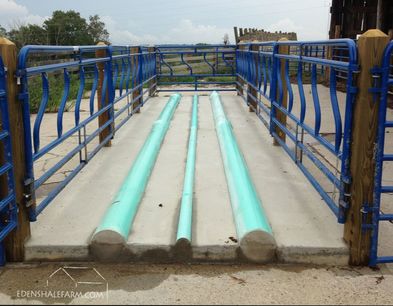 It is March and that means one thing for Kentucky farms, mud. It’s the time of year that the spring cows are in the middle of calving season and seemingly everyday involves fighting mud to do one of two things: check the cows and calves, and feeding hay. Although March is a tough time of the year to deal with the elements, it is also the perfect time of year to make plans for managing mud in the future. While the farm is “a mess” take time to evaluate which areas are troublesome and why they are a problem. Create scenarios that may alleviate the troubled area and decide what impacts it will have on other areas. A good way to start is to think about why you do a particular practice in the first place. Is it simply the way you have always done it? Did your father and grandfather do it that way before you? Sometimes we simply need to challenge our own thinking instead of defending what we are already doing. Begin by answering simple questions like, “Do the cows have enough access to hay and water without having to travel or fight for their share?” “How much mud to they have to endure to get their daily rations?” “Are you willing to travel through the same amount of mud on foot?” In reality cows are not much different than us, in that they want to avoid mud as much as possible. If given the opportunity they will choose a route or feeding option that has less mud, which is seen as an obstacle. Research has shown that a cow traveling in as little at 8 inches of mud has an increase in energy requirements by as much as 25% to maintain the same body condition score. Every farm has areas with 8+ inches of mud, and therefore has the opportunity to increase the efficiency of that animal by reducing the amount of mud, and therefore the amount of feed that animal will require. Think about locations. Decide if your winter feeding can be done differently or in another place. Can you harden or reinforce existing areas to alleviate the amount of mud around the hay? Is your feeding location in a well drained area that will promote drier conditions? Is driving the tractor on saturated soils causing more problems than it is helping? These are all things to consider when evaluating your operation. When developing solutions to managing mud try to create efficiencies. For example, if a new feeding area is to be developed, do so in a manner that allows it to be placed close to the hay source. Can you place it in a fence row so that you don’t have to drive the tractor into the field to feed hay? Is it possible to feed multiple groups from the same location? If there are buildings on your farm, develop a plan to harvest the rainwater from the roofs to be used to water the livestock. By making your operation for efficient you can reduce your bottom line and help make your farm more profitable. Try multiple scenarios. Not everything will work the way you want it to. As you try new methods you will find things that work and they will lead to other practices that pair and work well together. By doing this over time you slowly create a new system that may look completely different from your original model. It all starts with recognizing a problem and questioning how and why you do it. This is the process that we have worked through at Eden Shale Farm. Questioning why, and then coming up with new solutions. But let me say this, by no means have we eliminated mud on our farm. We are simply attempting to manage the mud. We control when the cows are exposed to mud and move them to areas that have been improved during times of highest stress (i.e. end of the winter, and calving season, etc). This allows the cattle to experience less stress due to environmental factors. If you would like to see some of the improvements that have been made at Eden Shale Farm, check out the blog at www.edenshalefarm.com or contact us for tour opportunities at 859-278-0899 or [email protected]. Comments are closed.
|
Archives
June 2024
Categories
All
Welcome |
CONTACT US |
EMAIL SIGN UP |
|
Eden Shale Farm
245 Eden Shale Rd. Office: (859) 278-0899 Owenton, KY 40359 Fax: (859) 260-2060 © 2021 Kentucky Beef Network, LLC.. All rights reserved.
|
Receive our blog updates
|

 RSS Feed
RSS Feed
